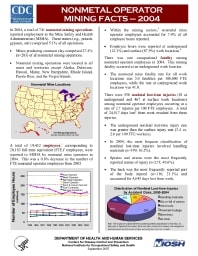Mining Publication: Nonmetal Operator Mining Facts - 2004
Original creation date: September 2007
Authors: National Institute for Occupational Safety and Health
NIOSHTIC2 Number: 20032736
Pittsburgh, PA: U.S. Department of Health and Human Services, Public Health Service, Centers for Disease Control and Prevention, National Institute for Occupational Safety and Health, DHHS (NIOSH) Publication No. 2007-169, 2007 Sep; :1-2
In 2004, a total of 741 nonmetal mining operations reported employment to the Mine Safety and Health Administration (MSHA). These mines (e.g., potash, gypsum, salt) comprised 5.1% of all operations. Mines producing common clay comprised 27.4% (n=203) of all nonmetal mining operations. Nonmetal mining operations were located in all states and territories except Alaska, Delaware, Hawaii, Maine, New Hampshire, Rhode Island, Puerto Rico, and the Virgin Islands. A total of 19,432 employees, corresponding to 20,183 full-time equivalent (FTE) employees, were reported to MSHA by nonmetal mine operators in 2004. This was a 0.6% decrease in the number of FTE nonmetal operator employees from 2003. Within the mining sectors, nonmetal mine operator employees accounted for 7.4% of all employee hours reported. Employee hours were reported at underground (12.1%) and surface (87.9%) work locations. There was one occupational fatality among nonmetal operator employees in 2004. This mining fatality occurred at an underground work location. The nonmetal mine fatality rate for all work locations was 5.0 fatalities per 100,000 FTE employees, while the rate at underground work locations was 41.0. There were 550 nonfatal lost-time injuries (83 at underground and 467 at surface work locations) among nonmetal operator employees occurring at a rate of 2.7 injuries per 100 FTE employees. A total of 24,517 days lost from work resulted from these injuries. The underground nonfatal lost-time injury rate was greater than the surface injury rate (3.4 vs. 2.6 per 100 FTE workers). In 2004, the most frequent classification of nonfatal lost-time injuries involved handling materials (n=199; 36.2%). Sprains and strains were the most frequently reported nature of injury (n=273; 49.6%). The back was the most frequently reported part of the body injured (n=116; 21.1%) and accounted for 4,645 days lost from work. In 2004, 28 cases of occupational illnesses were reported to MSHA by nonmetal operators. This compares to 36 cases in 2003. Joint, tendon, or muscle inflammation or irritation accounted for the most frequently reported occupational illnesses (n=13; 46.4%). In 2004, there were three cases of hearing loss or impairment reported to MSHA, or 10.7% of all illnesses. This compares to 12 cases (33.3%) in 2003. Other unclassified pneumoconiosis was reported for three nonmetal mine operator employees in 2004.

NIOSHTIC2 Number: 20032736
Pittsburgh, PA: U.S. Department of Health and Human Services, Public Health Service, Centers for Disease Control and Prevention, National Institute for Occupational Safety and Health, DHHS (NIOSH) Publication No. 2007-169, 2007 Sep; :1-2
- Coal and metal/nonmetal mining facts - 2008
- Coal and Metal/Nonmetal Mining Facts - 2008 (HTML)
- Coal Contractor Mining Facts - 2001
- Coal Contractor Mining Facts - 2002
- Coal Contractor Mining Facts - 2003
- Coal Contractor Mining Facts - 2004
- Coal Contractor Mining Facts - 2005
- Coal Contractor Mining Facts - 2006
- Mining Fact Sheets
- Rib Falls: A Major Ground Control Issue